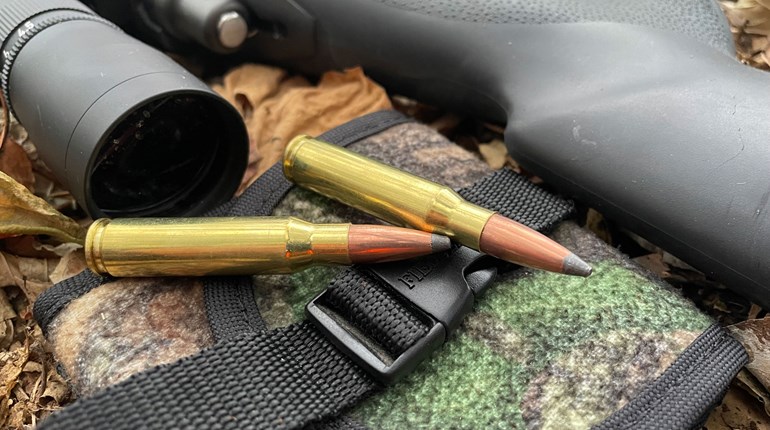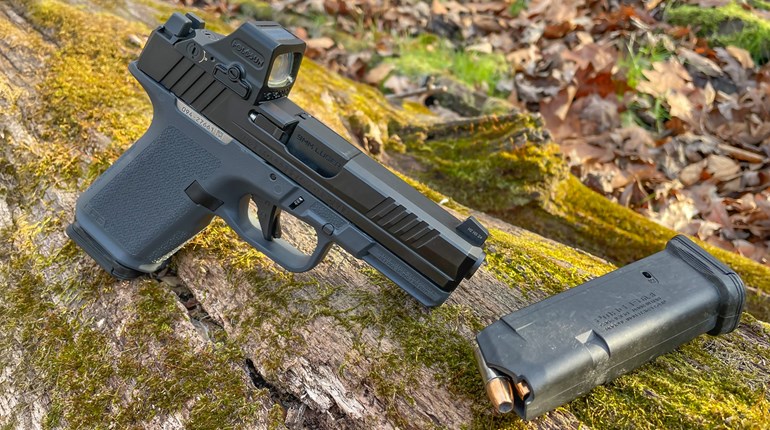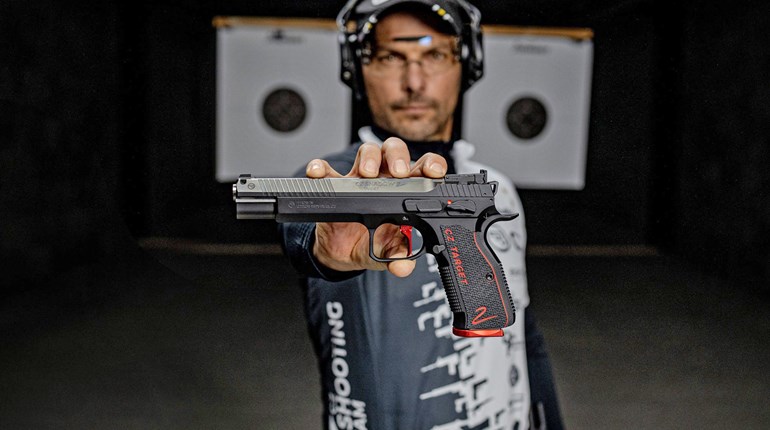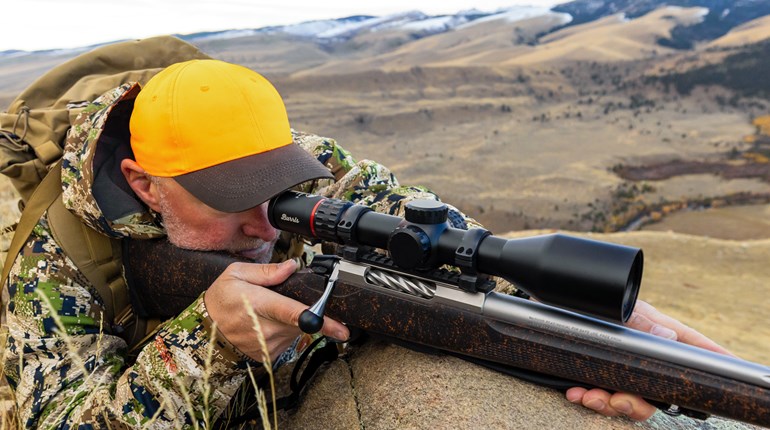
Marketers could learn from the actions of CZ-USA. First, CZ-USA captured headlines at the 2015 SHOT Show with the NFA-compliant version of the Scorpion EVO 3 A1, the S1 Pistol. Then, earlier this year, the company did it again, stealing media attention with the announcement of the Scorpion EVO 3 S1 Carbine and the highly anticipated debut of the civilian-legal CZ 805 Bren S1 Carbine. It was the 805 Bren S1 Carbine, however, that seized the limelight, and for good reason.

The Beginnings
On May 14, 1955, seven European satellites—including Czechoslovakia—and the Soviet Union signed an accord for mutual protection: If one member state was attacked, all signers of the document were obliged to defend it. Known as the Warsaw Pact, the treaty also named the Soviet Union as overseer of the armed forces of its members. Naturally, Soviet influence permeated to small arms development. It asserted that the armed forces of the Warsaw Pact utilize standard ammunition, in this case the ubiquitous 7.62x39 mm (M43) cartridge.

This mandate affected Czechoslovakia more than any other Warsaw Pact member state. Only recently before—from 1951 to 1952—the country created the Samonabijeci puska vzor 52 (vz. 52), which utilized its own proprietary (and more powerful) 7.62x45 mm cartridge. A number of existing vz. 52 rifles were re-chambered for the Russian round, and all new-manufacture vz. 52 rifles were renamed “vz. 52/57” to reflect the chambering change, as well as other differences to include the magazine. Production of the vz. 52/57 was short-lived, as the development of its replacement, the 7,62 mm samopal vzor 58 (vz. 58), began in the mid-50s. After several iterations, production of the vz. 58 began in earnest in 1959 at the Ceska zbrjovka Uhersky Brod (CZ) factory.
While other treaty members had issue rifles based upon the AK-47, Czechoslovakia had considerable latitude in creating the vz. 58. The vz. 58 was (and still is) a better design. The vz. 58 is a selective-fire, gas-operated rifle that employs a short-stroke piston for operation, which, because of the reduced heft of the moving parts and shorter piston movement, lessens vibration and gun movement. Other noteworthy differences include: a bolt-hold-open feature, a striker-fired mechanism, rotary bolt lockup, uncovered ejection port, lighter aluminum 30-round magazines that can be loaded via stripper clip while inserted, a milled-steel receiver and a superior lever-type mode/safety selector. Keep in mind that, although the vz. 58 has an appearance similar to that of the AK, parts are not interchangeable.

The vz. 58 faithfully served the Czechoslovakian military until the mid-1980s, when the 5.45x39 mm-chambered, AK-74-derived Lada was designed, tested, and, in 1989, approved for production. The timing couldn’t have been worse. The Revolutions of 1989 swept through Central and Eastern Europe and Czechoslovakia wasn’t immune; due to the “Velvet Revolution,” the Communist Party stepped down and the country was split into two nation states—the Czech Republic and Slovakia. Add to this the privatization of CZ and insufficient military funds, and it’s easy to see why the project wasn’t continued—at least at the time. It was resurrected as the CZ-2000, but never adopted.
CZ 805
Despite the disappointment of the Lada/CZ-2000 not being adopted by the Czech army, the reality was it still sought a new rifle. Interestingly, author Leszek Erenfeicht wrote on Small Arms Journal’s website, “The CZ 2000 was only a name used for PR. For in-house use, the whole ‘Army Rifle Replacement’ program was dubbed Project 805, according to the new classification scheme, in which model numbers were assigned according to the nature of the product.” Commencement of a new modular design coined the S805 began in 2005, with CZ creating specifications for two models—“A” and “B.” Mid-range calibers, such as 5.56 NATO and 7.62x39 mm, were found in the former, while the larger rounds were chambered in the latter. Within each letter designation, there were three, mission-specific barrel lengths labeled “1,” “2,” and “3.” The premise was the two platforms could be quickly and easily adapted to mission profiles in the field. In 2009, the Czech army issued a tender for a new infantry rifle.

But, CZ’s S805, which since had lost much of its modularity—only the “A” series was submitted—wasn’t the army’s only option; in fact, there were reportedly nearly 30 firearms submitted for testing. Eventually, the group was whittled down to the FN SCAR-L and CZ S805 (aka 805 Bren), which, as many gun enthusiasts are quick to point out, are quite similar aesthetically and functionally, with the SCAR-L predating the 805 Bren. But, domestic production gave CZ the edge and a sizable order of A1, A2, and G1 (grenade launcher-equipped rifles) guns with Meopta optics were purchased. Since then, the CZ 805 Bren has seen use in multiple conflicts.
A Closer Look
As with the CZ Scorpion EVO 3 A1 and S1 models, there are several major differences between the 805 Bren A1 and S1. First, and most obvious, gone is the four-position—safe, single round, two-round burst and full automatic—selector switch. In its place is a bilateral, two-position safety that, although positive, makes a loud snap when thumbing the short-throw, wide-paddle lever from “safe” to “fire.” Next, the A1’s and A2’s 11- and 14-inch, cold-hammer-forged, chrome-lined barrels have been replaced with a 16.2-inch version. Featuring 6-groove, 1:7-inch RH-twist rifling, even the heaviest .224-inch-diameter bullets will be stabilized. Additionally, the barrel, which measures a scant .550 inch at its thinnest, ends with a multi-port muzzle brake. The use of 1⁄2x28 RH threads on the S1 facilitates changing brakes, sound suppressors, etc.

As for specifics, the 805 Bren S1 is a gas-operated, semi-automatic carbine chambered in 5.56 NATO that utilizes a short-stroke piston—similar to that of its predecessor, the vz. 58 and its once-direct competitor, the FN SCAR-L. Part of the system is a two-position, user-adjustable gas tube/regulator that enables the shooter to select how much gas enters the system (i.e. for suppressor use, cleanliness, etc.). Rotating the gas tube/regulator 180 degrees allows the gas system to be removed for cleaning and/or maintenance. A bayonet lug on its bottom rounds out the gas block.
The rifle is divided into upper and lower receivers, with the latter being subdivided. First, the one-piece upper is machined from a billet of forged, aircraft-grade aluminum—no doubt contributing heavily to the gun’s 8.02-pound weight. Spanning the entire 16.75-inch length of the receiver’s top is Mil-Spec M1913 rail, which affords the user nearly endless options for adding optics. From the factory, the 805 Bren is equipped with dual-metal (aluminum/steel) flip-up sights. The protected-post front sight is adjustable for elevation, while the dual-aperture rear can be tweaked for windage. Beneath the fore-end is another 6.63 inches of usable Picatinny rail space for adding accessories, such as a vertical grip or lights and laser-sighting devices. A side cover plate is affixed to each side of the fore-end.

On the left side of the upper receiver is the petite, round, reciprocating charging handle. Since both sides have cocking slots, it can be quickly and easily be changed to the right side for left-handed shooters. Because of its reciprocating design, due caution is required to keep errant fingers out of its path. Whereas the changing handle can swap sides, the ejection port cannot. Fortunately, the polymer case deflector sends brass forward of the shooter so he or she isn’t hit, regardless of preferred shooting side. Sling-attachment points are found fore and aft of the receiver.
The lower receiver consists of two polymer units. Removing the disassembly pin forward of the magazine well allows the trigger mechanism unit—consisting of the hammer, fire controls, pistol grip and separate, but attached, magazine well—to be separated from the upper receiver. Because of the design, magazine wells for CZ’s proprietary HK-G36-like polymer magazine and that for the AR-15/M16 can be exchanged quickly. The 805 Bren S1 ships with the latter, which is likely the best option for everyone reading this article. The design makes cleaning the trigger mechanism easy.

While the safety selector and magazine release are bilateral, the bolt-catch button isn’t. The two-stage trigger is among the best I’ve encountered on a stock semi-automatic rifle—the trigger on the model I tested broke at a smooth 4 pounds, 9.8 ounces, exhibited no overtravel and had a short reset for rapid follow-up shots. Per the Czech army’s requested upgrades, the ergonomic pistol grip has a changeable backstrap, but the stock backstrap/frontstrap combination is quite comfortable. To enhance purchase, there are a series of ridges and grooves on the pistol grip’s sides and backstrap. The integral trigger guard has sufficient size to accommodate a gloved finger.

When the second disassembly pin—located aft of the safety—is withdrawn and the stock disassembly button pressed, the buttstock can be removed. After completing the aforementioned actions, the stock joint (and attached stock) slide downward, out of the T-groove and off the gun. The side-folding, telescoping polymer stock has four positions to accommodate varying lengths-of-pull as well as a raised cheekpiece for proper eye-to-optic alignment. From the factory, the cheekpiece is set for right-hand shooters, but reversing it for lefties is simple. Capping the buttstock is a .25-inch-thick rubber recoil pad with no tackiness.
Once the buttstock is removed, the recoil spring and buffer can be withdrawn, thereby permitting the charging handle to be removed (or swapped), and the steel bolt carrier to be removed. From here, it’s easy to access the six-lug bolt, the extractor and the plunger-type ejector. The owner’s manual cautions against the disassembly of the bolt carrier to remove the bolt. But, in humid conditions or after using the Bren in inclement weather, you will have to be able to do so. This simple task requires the removal of the firing-pin plug and the operation pin and takes about 30 seconds. It’s quite similar to stripping an AR’s bolt-carrier-group unit for maintenance.
In actuality, disassembly of the 805 Bren S1 Carbine is foolproof, and that’s desirable for an arm originally intended for military use. Part of the gun’s simplicity is derived from its modularity, but, as of now, other calibers aren’t available, so much of that is a moot point. I was also unable to locate replacement magazine wells and backstraps during a quick search. Nonetheless, the ease-of-care modularity affords makes it a great addition.

Range Time
I tested the 805 Bren S1 with a Bushnell scope mounted. Of the loads I put through the rifle, Nosler’s 62-grain FBHP Varmageddon produced the single best five-shot group and average. It was also the slowest by a wide margin—meaning the propellant probably wasn’t optimal for the 805’s 16.2-inch barrel.
None of the groups, however, were less than 1 inch, and the overall average for 75 shots was larger than anticipated. I attribute this to the 805 Bren S1’s pencil-thin barrel, coupled with conditions during testing and the side-folding buttstock. First, with a heat index approaching the mid-90s—the actual temperature was 89 degrees—and no breeze or shade, the barrel heated quickly and never fully cooled between strings. In most cases, the first three shots clustered extremely tightly, only to be ruined by those following. Additionally, as I’ve encountered on other rifles with side-folding buttstocks, even when “locked” into position, there is some vertical movement of the buttstock that affects accuracy at longer distances. The stock of the test 805 Bren S1 Carbine I received for testing had more than .19 inch of vertical movement.

I traded the Bushnell for a Weaver Tactical 1.5-7x24 mm to conduct handling and function testing. For this, I loaded the provided AR-15/M16-style magazines, as well as Lancer AWM and Magpul PMag 30-round variants, with a hodgepodge of .223 Rem. and 5.56 NATO loads. These included handloads and American- and Russian-made factory options. The 805 fed, fired, extracted and ejected flawlessly, regardless of the order in which they were loaded. Given that the 805 Bren A1 has already seen service in Afghanistan and Mexico, among other places, that’s unsurprising.

It’s when you’re off the bench, though, that the benefits of the 805’s design are especially apparent. The gun comes to shoulder quickly and has good balance. Due to the short-stroke piston, significant heft and excellent multi-port muzzle brake, recoil and muzzle rise are next to nil. The action of the 805 Bren S1 is as smooth as you’ll find.
Outside of the vertical “play” of the buttstock, there’s little I’d change on the 805 Bren S1. The Czech army, however, thought differently about the A1/A2. From their suggestions (or demands), the 806 Bren 2 was built with a lighter overall weight, a non-reciprocating charging handle, newly designed buttstock and a three-position gas system, among other things. Hopefully, a civilian-legal 806 Bren 2 will be available on the horizon. Until then, there’s the already-good 805.
For the shooter looking to get a piston-driven, 5.56 NATO-chambered defensive rifle, the CZ 805 Bren S1 should be at the top of the list. It reminds me of the CZ Scorpion
EVO 3 S1. Déjà vu, indeed.






































